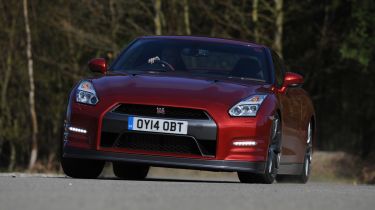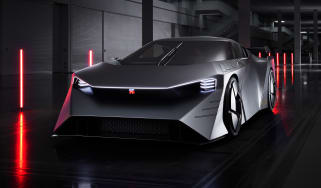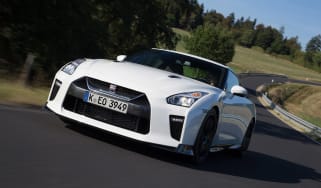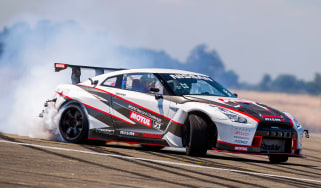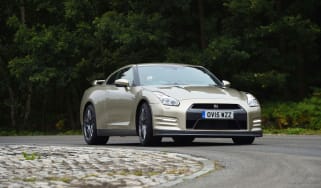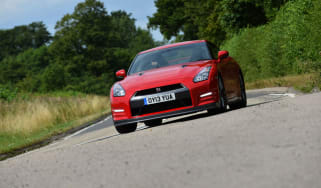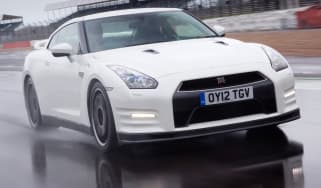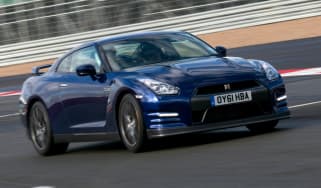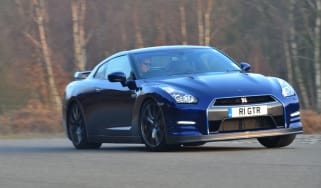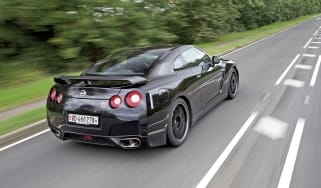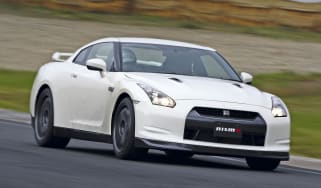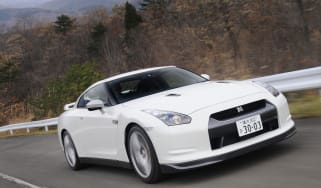Nissan GT-R (2009-2022) review
Japan’s iconic super coupe is showing its age, in spite of immense performance and a high-tech image

The Nissan GT-R has been with us for over a decade, but over that time the Japanese sports car has evolved, increased in price and successfully remained in contention with the best cars in the class – at least from a performance standpoint. Grip levels are stupendous, traction is tenacious and the acceleration on tap is awe-inspiring thanks to its fearsome twin-turbocharged 3.8-litre V6.
Despite its incredible performance, the GT-R feels a little dated next to a host of modern, more sophisticated rivals. The Nissan’s inflated price has put it up against talented rivals including the Porsche 911 and Aston Martin Vantage – both of which feel more special and nuanced. If sheer point-to-point speed is your goal, however, the GT-R still takes some beating.
About the Nissan GT-R
The Nissan GT-R has done an epic job as the Japanese marque’s performance flagship, with few cars able to catch the imagination of young enthusiasts in quite the same way. A carefully propagated PR and marketing effort before and after the GT-R’s 2007 launch cast the bruising coupe as a manga-style superhero, and thanks to a formidable investment in engineering and technology, the new model’s performance exceeded the hype. Rave reviews followed, and Nissan’s re-imagining of a little-known Japanese cult car born out of circuit racing in the late 1960s took the world by storm.
Used - available now

2020 Mercedes
E-Class Cabriolet
46,729 milesAutomaticDiesel2.9L
Cash £28,750
2023 Audi
Q7
34,798 milesAutomaticDiesel3.0L
Cash £36,000
2023 Peugeot
E-2008
17,417 milesAutomaticElectric
Cash £14,697
2020 Land Rover
Range Rover Evoque
42,000 milesAutomaticDiesel2.0L
Cash £16,197The current model is codenamed R35 by the factory, and it’s not the first GT-R to be sold officially by Nissan in the UK. The firm brought a limited number of R34 models over in the late 1990s, with more cars arriving independently as so-called ‘grey imports’.
Like its predecessors, the big Nissan GT-R is a technological tour de force that uses mechanical and electronic wizardry to make it one of the fastest accelerating cars for sale in the UK, even at nearly 15 years since its arrival.
The GT-R has a 0-60mph time that has been recorded as low as 2.7 seconds for the standard car, although Nissan doesn't currently quote a 0-62mph time in the GT-R brochure. However, this time puts it on a par with the fastest hypercars, as well as the all-electric Tesla Model S. While that car is a luxury car that's fast in a straight line, the GT-R uses motorsport-developed technology to deliver near-unbreakable grip and involving handling.
Power comes from a twin-turbocharged V6 engine (called VR38DETT) which has been upgraded over time, with output growing from 473bhp at launch in 2007 to 562bhp, or 592bhp in the GT-R Nismo. Every GT-R comes with four-wheel drive and a 6-speed twin-clutch automatic gearbox with paddle shifters. There's a limited-slip differential, adaptive dampers and a host of electronic driver aids on board that help move power between the wheels to deliver incredible traction and grip, although later cars have been tweaked to deliver a more involving driving experience.
This equipment helps the GT-R to feel more agile than its 1,752kg kerbweight would lead you to believe, and the GT-R is an engaging driver's car on the right road. However, it's also a very compromised sports car. While the four-seater layout is practical, and there's even a decent boot, the firm ride, even in the most comfortable damper setting, means the GT-R is an endurance in everyday use, while the complex four-wheel-drive transmission ties itself in knots when manoeuvring at low speeds.
As well as the standard GT-R, Nissan offers the even faster GT-R Nismo, which has been fettled by Nissan's motorsports division to offer an even more focused performance. This includes lighter Rays forged alloy wheels and a carbon fibre bodykit that improves aerodynamics, as well as the more powerful 592bhp engine. The Track Edition bridges the gap between the standard GT-R and the Nismo, as it has the Nismo's Rays wheels and Nismo-tuned dampers, but does without the Nismo's bodykit or extra power.
Time has seen the GT-R get more power, but it has also seen prices rise at a dramatic rate. When launched, the GT-R cost around £55,000, making it something of a performance car bargain. But today Nissan makes you pay for the GT-R's badge appeal, with a starting price of around £84,000, while the Track Edition is over £100,000 and the Nismo is priced at £184,000. Those are big numbers to swallow, especially when you consider the car's age.
For real connoisseurs of the GT-R brand, the ultimate option is the limited edition GT-R50 by Italdesign revealed in 2020 to celebrate its 50th anniversary. With stunning bespoke bodywork and a power hike to 710bhp, production has been limited to 50 examples costing almost £900,000 each. Collectors only needed to apply...
There aren't really any direct rivals for the Nissan GT-R. The Audi RS 5 Coupe comes closest to the four-seat, four-wheel drive coupe formula, but it can't match the GT-R's performance. Instead you'd need to look at the Audi R8 for similar pace, or the Porsche 911 Carrera 4 or Panamera. However, all of these cars have a far greater finesse than the GT-R.
Elsewhere, if a hi-tech Japanese sports car floats your boat, then the Honda NSX is available, or even the Lexus LC. Or you might consider the Toyota Supra, another car that trades on its heritage, but with a far more reasonable price. But if straight-line acceleration is what you're after, then the Tesla Model S with Ludicrous mode is about the only car at a similar price that can carry four (or more) and deliver the same kind of acceleration.
Engines, performance and drive
The Nissan GT-R is a genuine technological tour de force, and its advanced Electronic Stability Control system and adaptive dampers can be configured to suit road and track driving. In the most extreme R setting, the Nissan demonstrates remarkable agility and can rip along twisting back roads at barely believable speed. Even so, the GT-R can’t defy the laws of physics and you’re constantly aware of the car’s hefty weight.
Revisions to the suspension have resulted in a softer ride around town, while low-speed steering assistance has been increased in a bid to improve manoeuvrability. Factor in the extra sound deadening, and the GT-R is now more civilised for day-to-day use – but it's not perfect. Along with that all-wheel-drive system that clunks and groans at low speed, there’s plenty of tyre roar on the motorway due to the huge, low-profile tyres.
The Track Edition, with its Nismo-sourced suspension, makes a marked step up over the already extremely capable GT-R; and, on a track at least, it takes only one corner to realise how much more speed you can carry thanks to the extra stability and stiffness the suspension brings. The Track Edition makes the normal car feel a little soft in comparison, and is reassuringly planted, with unrivalled mechanical grip, resulting in a greater sense of precision through the steering wheel, encouraging you to push on. Fine if you're a track day regular, but we suspect it may be feel rather firm over the rough and rutted UK tarmac on our roads.
And, then there's the full-fat GT-R Nismo... Thanks to its stiffer springs and Bilstein dampers, revised suspension geometry and hip-hugging Recaro seats, the driving experience of this even more focused version is far more extreme and less comfortable than the standard car. As a result, the Nismo always feels more at home on a race track than a road, but that's no real surprise, as it was developed specifically to lap the Nurburgring Nordschleife as quickly as possible, achieving a bonkers lap time of 7 minutes 8.69 seconds.
Away from the track – if you can face it – the Nismo is no less than one of the fastest road cars we are likely to drive. As well as having that extra power, a strict diet of carbon fibre has reduced the weight of the car by 30kg, and Nissan has made a huge step forward in aerodynamics: the Nismo produces an extra 100kg of downforce in corners, gluing it to the road in a manner that regular GT-R drivers would struggle to fathom.
There's precious little in the way of ride comfort, but the Nismo's main purpose is to deliver scorching thrills on the road with massive dynamic ability, and it achieves that aim with miles of room to spare. The noise emanating from the exhaust is notably louder and more exciting than the standard car’s, and the straight-line performance certainly feels stronger, too.
Engines, 0-60 acceleration and top speed
The car's 3.8-litre twin-turbo V6 engine delivers 562bhp with 637Nm of torque, and launch control helps the GT-R blast from 0-62mph in just 2.7 seconds. However, the car's electronics restrict its use, and after doing two full-bore launches, launch mode is disabled for an hour to let the car's drivetrain recover - that's not something that you need to do in a launch control-equipped Porsche 911, for example.
Acceleration is brutal thanks to the GT-R’s excellent four-wheel-drive transmission and six-speed twin-clutch gearbox. The paddleshift set-up provides seamless power delivery and super-smooth gearchanges – it can even be used as a full auto, where it’ll shuffle gears around smoothly and without fuss.
The only slight gripe with the transmission is the grumbling noises it produces when manoeuvring at low speed. It doesn’t sound too healthy, as the diffs chunter and whine, but reliability is good and this little quirk only adds to the GT-R’s focused personality.
Strangely, Nissan doesn't quote a 0-62mph time for the more powerful 592bhp and 652Nm GT-R Nismo, but has hinted that 0-62mph in 2.5 seconds is possible.
MPG, CO2 and running costs
It used to be something of a performance car bargain, but on the face of it, the Nissan GT-R isn’t cheap, following some steady increases in price. True, the basic model can deliver the kind of performance you would expect from a car costing nearly twice as much, but there are plenty of slower Porsche 911s that may tempt you for the same money.
Running costs will be in the supercar category thanks to expensive tyres, steep servicing and pricey insurance. And you’ll need to budget for big fuel bills, too – Nissan claimed 23.9mpg on the NEDC test cycle, but WLTP testing has seen that figure decrease to a best of 20.2mpg for the lower powered engine and 19.6mpg for the Nismo. These figures will drop to single digits if you utilise the car’s full performance potential. 275g/km CO2 emissions mean high tax bills for company car users, too.
Insurance groups
There’s not much out there that can go meaningfully faster on the Queen’s highway, and as a result GT-R owners can expect pretty steep insurance quotes based on a Group 50 rating for the whole range.
Depreciation
Older-generation Nissan Skyline GT-Rs are popular with performance car enthusiasts, because they offer stonking performance and potential from easy upgrades. Nissan only ever imported a handful of R33 and R34 GT-Rs into the UK. A number of cars also came to the UK as grey imports, but their cult status means their value remains high.
Depreciation for the R35 GT-R is very good, with figures quoted in the 60 per cent range, which makes it one of the best cars for sale for retained value after three years.
However, considering the car costs upwards of £80,000, you'll still lose plenty of cash, although if you can afford a GT-R, then you probably can take the hit. In comparison, the Porsche 911 Carrera 4 is in the mid 50 per cent range – and you’ll lose more again on all the extras you had to buy to match the GT-R’s spec.
To get an accurate valuation on a specific model check out our free car valuation tool...
Interior, design and technology
The sheer scale of the Nissan GT-R gives it huge road presence. Even cars costing twice as much will struggle to match the imposing styling of Nissan’s angular coupe. It’s not exactly pretty, but with four huge exhaust pipes, circular tail-lights and vast alloy wheels, it never fails to turn heads. Its evocative badge doesn’t hold the universal appeal of an Italian thoroughbred, but for its fans, there’s nothing to rival the appeal of the GT-R logo.
The Nismo model marks itself out with unique front and rear bumpers, deeper side skirts and a carbon boot lid with a huge rear wing attached to it. It's not just for show either, as Nissan says the Nismo produces an extra 100kg of downforce compared to the standard model at 186mph.
Less exotic is the interior, which lacks the quality and design you’d expect from a classy coupe, although it was vastly improved for the 2017 model year. Some of the plastics look still look and feel a little cheap, but the touchscreen system has allowed Nissan to tidy up the dash, and there’s softer nappa leather for a more luxurious feel.
Despite the lacklustre interior design, the car’s exterior styling still turns heads – where rivals have released all-new, fresher-looking models, the GT-R has remained relatively constant in design terms, with only minor tweaks over the years. But that’s no bad thing, as the car still has a legion of loyal fans.
Sat-nav, stereo and infotainment
A comprehensive data logger that records everything from cornering g-forces to lap times, means the GT-R has an impressive techy feel that fits with the Nissan’s character. Most of the car’s functions are now controlled by an eight-inch touchscreen, although the system isn’t the most intuitive and doesn’t have very modern graphics.
Practicality, comfort and boot space
Given the performance available, the big Nissan is surprisingly practical. However, there’s not a lot of storage, with only a glovebox, a pair of cup holders and cramped door pockets for all your odds and ends.
Technology lovers will cherish the multifunction display at the centre of the dashboard, because it provides information on everything from cornering g-forces to turbo boost pressure. However, the switchgear and cabin plastics are better suited to a supermini than a supercar, and the bluff dashboard looks basic. It comes with loads of standard kit, but possibly not the sense of occasion you expect from a 196mph sports car.
It's also worth restating that the car’s firm ride and noisy tyres mean it’s not really a relaxed cruiser. Other potential rivals like the Porsche 911 or Audi R8 offer a greater degree of suspension compliance and rde comfort, while BMW’s big M8 Coupe has a completely different feel and is more expensive, but is certainly more luxurious, too.
Dimensions and size
The Nissan GT-R doesn’t feel that small and wieldy on the road, and the dimensions back that up. It’s 4,710mm long, 1,895mm wide, and 1,370mm tall, which makes it a fair bit bigger than the Porsche 911, which measures 4,499mm x 1,852mm x 1,298mm.
Leg room, head room & passenger space
Adults are unlikely to be able to squeeze into the rear seats for anything but a very short trip, but they’re fine for children and extra luggage. Occupants up front get plenty of head and legroom, while the driver benefits from lots of seat and wheel adjustment.
Boot space
There’s even a decent 315-litre boot – although it suffers from a high loading lip. At least it’s a usable shape, though, with no funny protrusions, and it’s big for a supercar. It will easily swallow a pair of suitcases or golf clubs.
Reliability and safety
A host of electronic driver aids are designed to keep the Nissan GT-R on the straight and narrow, and you get six airbags as standard. As it's a relatively low production super sports car, the GT-R hasn’t been through the Euro NCAP crash test programme, but with such a super-stiff chassis, the big coupe should be a strong performer if you manage to overcome the hi-tech electronics. That said, with a top speed knocking on the door of 200mph, if you do get into trouble things could get ugly.
On the other hand, big brakes and grippy tyres mean the GT-R should be able to outperform most things on the road, and with its high reserves of grip and performance, the car should remain composed if you need to perform an extreme avoidance manoeuvre.
The GT-R went through extensive testing before it went on sale, of course, but there were some early question marks about how the car's complex four-wheel drive transmission would cope once miles begin to build. Some owners of early cars experienced expensive failures of the GT-R’s complex twin-clutch gearbox. However, with the more recent models, Nissan seems to have cured the problem.
Even though the GT-R is too niche to make an appearance in the Driver Power satisfaction survey, its individual scores contribute to Nissan's overall manufacturer ranking. It does reasonably well, regularly placing in the top half, and achieving 11th spot in 2020. However, while owners of other Nissans praise their running costs and practicality, and deride performance, these scores will be the opposite for the GT-R.
Warranty
If there are any mechanical maladies, it’s encouraging to know that the GT-R is covered by the same three-year/60,000-mile warranty as other Nissan models.
Servicing
Nissan has a number of specialist GT-R dealers trained to maintain this hi-tech machine. Servicing intervals depend on how you drive the car, but at the very least you’ll be visiting your dealer once a year or every 12,000 miles.
Nissan Skyline GT-R history
The current R35 Nissan GT-R can trace its roots to 1969, when the first GT-R arrived as a high performance version of the Nissan Skyline. The first Skyline GT-R is known as the KPGC10, which was sold as a four-door saloon, then a two-door coupe. It used a 2.0-litre straight-six and five-speed manual gearbox, and this layout was also used for the second GT-R, the KPGC110, launched in 1973.
The fuel crisis of the Seventies saw the GT-R disappear, and only 197 GT-R Mk2s were built, making it a highly collectable classic today. The straight-edged Skyline GTS-R of the Eighties filled the void left by the GT-R, especially in motorsport, while the all-new R32 Skyline GT-R arrived in 1989. This car featured the basic ingredients of the current car, with four-wheel drive, and a twin-turbo six-cylinder engine. Racing versions dominated Group A touring car racing where the GT-R first earned the nickname Godzilla. Eventually the R32 GT-R was outlawed, essentially for being too competitive.
The R33 GT-R was larger and more hi-tech than the R32, and it arrived in 1995, while the R34 Skyline GT-R arrived in 1999. These models pushed the technology envelope even further. The R33 GT-R had a brief adventure at the Le Mans 24 Hours, but the later R34 GT-R only appeared in the Japanese SuperGT domestic sports car championship.
When the current R35 GT-R was revealed in 2007, it was five years after the R34 was dropped. As well as continuing to compete in the SuperGT championship, the GT-R has become a competitive racer in various GT3 sports car racing series across the world, while Nissan's ill-fated 2014 Le Mans entry was named the GT-R LM Nismo, although shared nothing technical with the road car.
One thing that has helped the Nissan GT-R establish itself as a fan favourite is its appearance in the entertainment industry. Whether it's video games such as Gran Turismo and Need For Speed, or the Fast And The Furious movie franchise, these outlets have helped the GT-R gain mythical status with fans.
